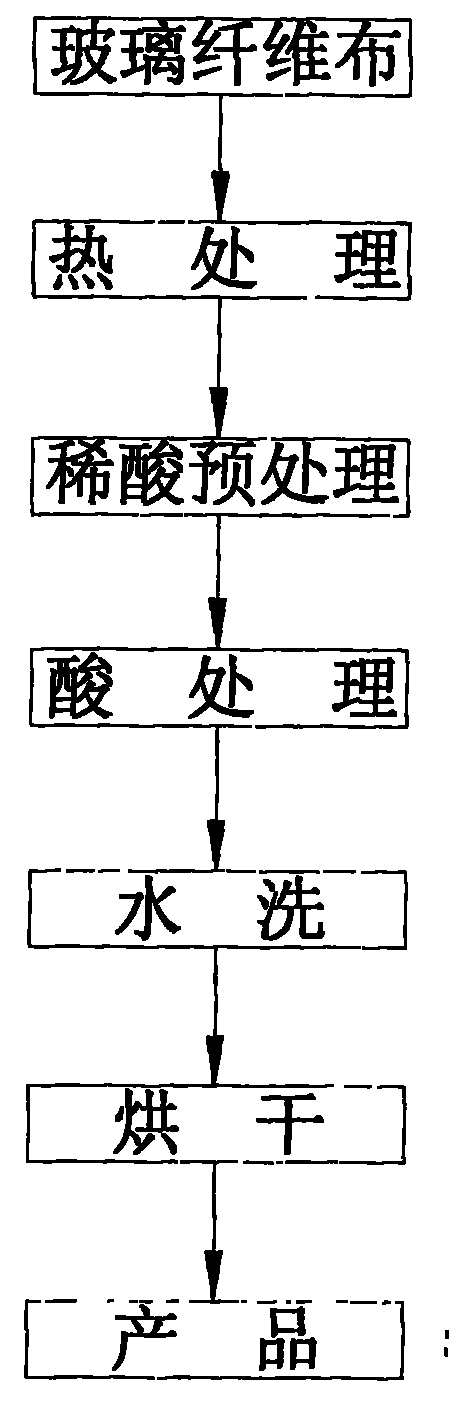Preprocessing method for glass fiber cloth
A glass fiber cloth and pretreatment technology, which is applied in the direction of fiber treatment, textile material treatment, chemical instruments and methods, etc., can solve the problem of not being able to make good use of high specific surface area, low photocatalyst surface adhesion, and reduced catalytic activity, etc. problems, to achieve low cost, high production efficiency, and improve surface activity
- Summary
- Abstract
- Description
- Claims
- Application Information
AI Technical Summary
Problems solved by technology
Method used
Image
Examples
Embodiment 1
[0034] Cut the non-alkali glass fiber cloth (silica content 53.4wt%) with the specification of 3784-92 into 500mm square cloth, put it into the muffle furnace that has been heated to 520±10°C, keep it warm for 50min, take it out and cool it to At room temperature, then immerse it in 0.1M HCl solution, take it out after 5min and immediately put it into 3.5M, 98℃ HCl+HNO 3 Mixed solution (M HCl / M HNO3 The concentration ratio is 25:1), soak for 240 minutes, take it out and rinse it with tap water immediately, until the pH value of the surface of the cloth is tested with a wide range of test paper is greater than 6, then take it out, and finally put it in an oven for 30 minutes at 115 ° C, take it out, and cool it. product.
[0035] Product performance analysis results: the silica content is 94.3% (weight percentage); the average pore diameter of the porous structure is 15.6 μm; the specific surface area is 127.5m 2 / g; temperature resistance above 1000°C.
Embodiment 2
[0037] Cut the ternary high-silica glass fiber cloth (silica content 67.8wt%) with the specification of 1584-92 into 500mm square cloth, put it into the muffle furnace which has been heated to 450±10°C, and keep it warm for 40min. Take it out and cool it to room temperature, then immerse it in 0.1M HCl solution, take it out after 4min and immediately put it in 3.0M, 92°C HCl+HNO 3 Mixed solution (M HCl / M HNO3 The concentration ratio is 25:1), take it out after soaking for 120 minutes, and immediately rinse it with tap water until the pH value of the surface of the cloth is tested with a wide range of test paper is greater than 6, then take it out, and finally put it in an oven and dry it at 105°C for 20 minutes, take it out, and cool it down. product.
[0038] Product performance analysis results: the silica content is 95.6% (weight percentage); the average pore diameter of the porous structure is 8.6 μm; the specific surface area is 78.6m 2 / g; temperature resistance abov...
Embodiment 3
[0040] Cut the non-alkali glass fiber cloth (silica content 54.2wt%) with the specification of 3784-92 into 500mm square cloth, put it into the muffle furnace which has been heated to 480±10°C, keep it warm for 50min, take it out and cool it to At room temperature, then immerse it in 0.1M HCl solution, take it out after 4min and immediately put it into 4.0M, 100℃ HCl+HNO 3 Mixed solution (M HCl / M HNO3 The concentration ratio is 25:1), take it out after soaking for 180 minutes, and immediately rinse it with tap water until the pH value of the surface of the cloth is tested with a wide range of test paper is greater than 6, then take it out, and finally put it in an oven and bake it at 110°C for 25 minutes, take it out, and cool it down. product.
[0041] Product performance analysis results: the silica content is 93.8% (weight percent); the average pore diameter of the porous structure is 13.8 μm; the specific surface area is 121.4m 2 / g; temperature resistance above 1000°C...
PUM
| Property | Measurement | Unit |
|---|---|---|
| Specific surface area | aaaaa | aaaaa |
| Specific surface area | aaaaa | aaaaa |
| Specific surface area | aaaaa | aaaaa |
Abstract
Description
Claims
Application Information
 Login to View More
Login to View More - R&D
- Intellectual Property
- Life Sciences
- Materials
- Tech Scout
- Unparalleled Data Quality
- Higher Quality Content
- 60% Fewer Hallucinations
Browse by: Latest US Patents, China's latest patents, Technical Efficacy Thesaurus, Application Domain, Technology Topic, Popular Technical Reports.
© 2025 PatSnap. All rights reserved.Legal|Privacy policy|Modern Slavery Act Transparency Statement|Sitemap|About US| Contact US: help@patsnap.com

